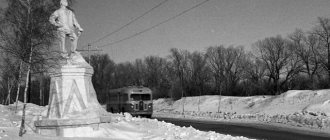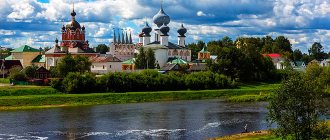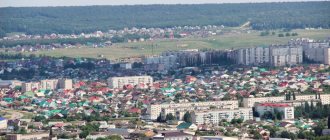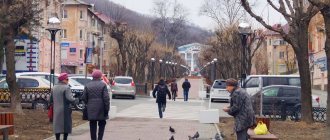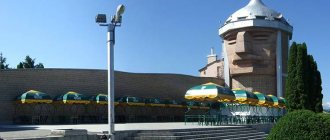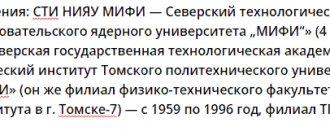This term has other meanings, see Novomoskovsky district.
| district[1] / urban district[2] | |
| Novomoskovsky district, Novomoskovsk city | |
| Flag | Coat of arms |
- (3,5 %)
Novomoskovsky district
- administrative-territorial unit (district)[5][6][7] in the Tula region of Russia.
Within the boundaries of the district there is a municipal entity, the city of Novomoskovsk.
with the status of a city district[8].
The administrative center is the city of Novomoskovsk.
Story
The district was formed on August 1, 1958 under the name Stalinogorsk
from the territory subordinate to the Stalinogorsk City Council and the territory of the abolished Gremyachevsky district[9].
On November 13, 1961, in connection with the renaming of Stalinogorsk to Novomoskovsk, the district was renamed Novomoskovsky
.
In 2000, the district included:
- Sokolniki city
and 13 rural districts:
- Gremyachevsky - p. Gremyachee
- Ivan-Ozersky - Maloye Kolodeznoye village
- Klyuchevsky - Krasnoye Gremyachevo village
- Kommunarsky - village Kommunarov
- Krasnobogatyrsky - Krasny Bogatyr village
- Ozerkovsky - Ozerki village
- Pervomaisky - village Pervomaisky
- Pravdinsky - Pravda village
- Prokhorovsky - Prokhorovka village
- Riga-Vasilievsky - village Riga-Vasilievka
- Spassky - p. Spasskoye
- Shirinsky - Shirinsky village
- Shishlovsky - p. Shishlovo
In 2006, a municipal district was created within the boundaries of the district and district center as part of the organization of local self-government. The city of Novomoskovsk became part of it as an urban settlement and ceased to be a city of regional subordination.
Municipal district from 2006 to 2008 divided into 5 municipalities:
- 2 urban settlements: the city of Novomoskovsk
- Sokolniki city
- Gremyachevskoye - village Gremyachee
In 2008, the urban settlement of the city of Novomoskovsk was transformed into the municipal formation of the city of Novomoskovsk
with the status of an urban district with the subsequent annexation to it of all settlements located on the territory of the municipal district.
Thus, since 2009, one municipal entity has been located on the territory of the district - the city of Novomoskovsk
with the status of an urban district.
Novomoskovsky district as an administrative-territorial unit of the region retains its status[6].
The city of Sokolniki was annexed to the city of Novomoskovsk by the decision of the Tula Regional Duma of October 24, 2008[10].
General information
Tula is a large transport hub - there are a large number of federal highways in the area, as well as the Moscow-Voronezh and Kaluga-Tula-Ryazhsk railway lines.
Agriculture is well developed in Novomoskovsk, since the climate of this area is favorable for agriculture and livestock raising.
The region's industry is represented by enterprises in the energy, chemical, construction and food industries. There are about 100 large enterprises alone, which creates environmental problems.
Among other cities, Novomoskovsk stands out for its amenities. Three times took prizes among cities in the competition “The Most Comfortable City in Russia.”
The city has interesting sights - many monuments, historical monuments and religious shrines.
Population
Area
| Population | |||||
| 1959[11] | 1970[12] | 1979[13] | 1989[14] | 2002[15] | 2009[16] |
| 37 038 | ↘31 287 | ↘26 734 | ↘26 289 | ↘25 211 | ↗145 252 |
| 2010[17] | 2011[18] | 2012[19] | 2013[20] | 2014[21] | 2015[22] |
| ↘143 848 | ↘143 347 | ↘142 626 | ↘141 159 | ↘140 007 | ↘139 234 |
| 2016[23] | 2017[24] | 2018[25] | 2019[26] | 2020[27] | 2021[4] |
| ↘138 447 | ↘137 555 | ↘136 635 | ↘134 932 | ↘133 791 | ↘133 021 |
Urban district
| Population | |||||
| 2009[18] | 2010[17] | 2011[18] | 2012[19] | 2013[20] | 2014[21] |
| 145 252 | ↘143 848 | ↘143 347 | ↘142 626 | ↘141 159 | ↘140 007 |
| 2015[22] | 2016[23] | 2017[24] | 2018[25] | 2019[26] | 2020[27] |
| ↘139 234 | ↘138 447 | ↘137 555 | ↘136 635 | ↘134 932 | ↘133 791 |
| 2021[4] | |||||
| ↘133 021 | |||||
Urbanization
The urban population (city of Novomoskovsk) makes up 91.47% of the total population of the district (urban district).
Settlements
The district (urban district) includes 98 settlements, including 1 urban and 97 rural:
| List of settlements | |||
| № | Locality | Type of settlement | Population |
| 1 | Akulshino | village | 15[17] |
| 2 | Alexandrovka | village | 0[17] |
| 3 | Almazovo | village | 18[17] |
| 4 | Belokolodez | village | 11[17] |
| 5 | Belomestnoe | village | 27[17] |
| 6 | Berezovka | village | 61[17] |
| 7 | Bogdanovka | village | 279[17] |
| 8 | Big Sagittarius | village | 11[17] |
| 9 | Big Teterki | village | 2[17] |
| 10 | Bolshoye Kolodeznoye | village | 84[17] |
| 11 | Borozdino | village | 3[17] |
| 12 | Vasilyevka | village | 9[17] |
| 13 | Verkhniy Yasenok | village | 0[17] |
| 14 | Verkhodonye | village | 65[17] |
| 15 | Grayvoronki | village | 18[17] |
| 16 | Gremyachevo | village | 41[17] |
| 17 | Gremyachee | village | 1337[17] |
| 18 | Gritsovo | village | 188[17] |
| 19 | Doctorovo | village | 4[17] |
| 20 | Erzovka | village | 7[17] |
| 21 | Znamenka | village | 12[17] |
| 22 | Znamensky | village | 2[17] |
| 23 | Ivan-Ozero | village | 103[17] |
| 24 | Ivankovo | village | 4[17] |
| 25 | Izbishchi | village | 170[17] |
| 26 | Ilyinka 1st | village | 221[17] |
| 27 | Ilyinka 2nd | village | 81[17] |
| 28 | Klyuchevka | village | 177[17] |
| 29 | Knyaginino | village | 136[17] |
| 30 | Kommunarov | village | 494[17] |
| 31 | Krasnoye Gremyachevo | village | 158[17] |
| 32 | Red Bogatyr | village | 787[17] |
| 33 | Crosses | village | 42[17] |
| 34 | Kukuy | village | 24[17] |
| 35 | Lyubovka | village | 9[17] |
| 36 | Maklets | village | 206[17] |
| 37 | Maksheevo | village | 14[17] |
| 38 | Malinovsky | village | 103[17] |
| 39 | Maloe Kolodeznoye | village | 101[17] |
| 40 | Malye Teterki | village | 0[17] |
| 41 | Matov Sad | village | 0[17] |
| 42 | Matt | village | 13[17] |
| 43 | Peaceful | village | 25[17] |
| 44 | Mikhailovka | village | 1[17] |
| 45 | New Village | village | 2[17] |
| 46 | Novomoskovsk | city | ↘121 674[4] |
| 47 | Novo-Yakovlevka | village | 17[17] |
| 48 | Ozerki | village | 300[17] |
| 49 | Olkhovets | village | 270[17] |
| 50 | Orlovka | village | 0[17] |
| 51 | Osanovo | village | 25[17] |
| 52 | Pashkovo | village | 11[17] |
| 53 | Pervomaisky | village | 901[17] |
| 54 | Petrovochka | village | 94[17] |
| 55 | Flat | village | 25[17] |
| 56 | Podlubnoe | village | 0[17] |
| 57 | Podosinki-Kozhino | village | 7[17] |
| 58 | Similar Vyselki | village | 0[17] |
| 59 | Is it true | village | 471[17] |
| 60 | Prigorye | village | 2[17] |
| 61 | Pridonye | village | 74[17] |
| 62 | Prokhorovka | village | 22[17] |
| 63 | Prudki | village | 10[17] |
| 64 | Wasteland | village | 41[17] |
| 65 | Pushkari | village | 59[17] |
| 66 | Riga-Vasilievka | village | 177[17] |
| 67 | Savino | village | 397[17] |
| 68 | Garden | village | 84[17] |
| 69 | Sergeevka | village | 11[17] |
| 70 | Simakovo | village | 0[17] |
| 71 | Sokolniki 1 | village | 1[17] |
| 72 | Sokolniki 2 | village | 12[17] |
| 73 | Spasskoye | village | 1751[17] |
| 74 | Gritsovo station | village | 24[17] |
| 75 | Staraya Uvarovka | village | 5[17] |
| 76 | Sentry | village | 6[17] |
| 77 | Sagittarius | village | 127[17] |
| 78 | Tetyakovka | village | 29[17] |
| 79 | Tikhonovka | village | 11[17] |
| 80 | Ulanovka | village | 1[17] |
| 81 | Urusovo | village | 12[17] |
| 82 | Fustovo | village | 8[17] |
| 83 | Khlopovo | village | 0[17] |
| 84 | Khmelevka | village | 110[17] |
| 85 | Kholtobino | village | 360[17] |
| 86 | Chusovka | village | 4[17] |
| 87 | Shatovka | village | 2[17] |
| 88 | Mines No. 35 | village | 2[17] |
| 89 | Mines No. 38 | village | 0[17] |
| 90 | Shirino | village | 6[17] |
| 91 | Shirinsky | village | 1548[17] |
| 92 | Shishlovo | village | 260[17] |
| 93 | Yudino | village | 3[17] |
| 94 | Yudino | village | 61[17] |
| 95 | Yasenok-Vyselki | village | 4[17] |
| 96 | Yasenok-Muravyovka | village | 0[17] |
| 97 | Yasenok-Podlubnoe | village | 6[17] |
| 98 | Yatskoe | village | 46[17] |
Notes
- from the point of view of the administrative-territorial structure
- from the point of view of the municipal structure
- Regions of Russia. Basic socio-economic indicators of cities. 2022.. - Moscow, 2022. - P. 98. - 456 p.
- ↑ 1234
The permanent population of the Russian Federation by municipalities as of January 1, 2022 (Russian). Retrieved April 27, 2022. Archived May 2, 2022. - Charter of the Tula region
- ↑ 12
Law “On the administrative-territorial structure of the Tula region” - ATU (undefined)
. Archived from the original on November 15, 2016. - Charter of the municipal formation of the city of Novomoskovsk: Article 1. Name of the municipal formation and its legal status 1. Name of the municipal formation - city of Novomoskovsk. The status of the municipality is urban district.
- Administrative-territorial division of the Tula region for 1917-1989 (undefined)
. Archived from the original on August 24, 2011. - On the annexation of the city of Sokolniki, Novomoskovsk district, Tula region, to the city of Novomoskovsk, Novomoskovsk district, Tula region (unspecified)
(inaccessible link). Access date: August 25, 2009. Archived November 25, 2010. - All-Union Population Census of 1959. The actual population of cities and other settlements, districts, regional centers and large rural settlements as of January 15, 1959 by republics, territories and regions of the RSFSR (unspecified)
. Retrieved October 10, 2013. Archived October 10, 2013. - All-Union population census of 1970. The actual population of cities, urban-type settlements, districts and regional centers of the USSR according to census data as of January 15, 1970 by republic, territory and region (unspecified)
. Retrieved October 14, 2013. Archived October 14, 2013. - All-Union Population Census of 1979. The current population of the RSFSR, autonomous republics, autonomous regions and districts, territories, regions, districts, urban settlements, village-district centers and rural settlements with a population of over 5,000 people (unspecified)
. - All-Union population census of 1989. Urban population (undefined)
. Archived from the original on August 22, 2011. - All-Russian population census 2002. Volume. 1, table 4. Population of Russia, federal districts, constituent entities of the Russian Federation, districts, urban settlements, rural settlements - regional centers and rural settlements with a population of 3 thousand or more (unspecified)
. Archived from the original on February 3, 2012. - The size of the permanent population of the Russian Federation by cities, urban-type settlements and regions as of January 1, 2009 (unspecified)
. Retrieved January 2, 2014. Archived January 2, 2014. - ↑ 1 2 3 4 5 6 7 8 9 10 11 12 13 14 15 16 17 18 19 20 21 22 23 24 25 26 27 28 29 30 31 32 33 34 35 36 37 38 39 40 41 42 43 44 45 46 47 48 49 50 51 52 53 54 55 56 57 58 59 60 61 62 63 64 65 66 67 68 69 70 71 72 73 74 75 76 77 78 79 80 81 82 83 84 85 86
87 88 89 90 91 92 93 94 95 96 97 98 99 All-Russian population census 2010.
Number and distribution of the population of the Tula region (unspecified)
. Access date: May 18, 2014. Archived May 18, 2014. - ↑ 123
Tula region. Estimated resident population as of January 1, 2009-2013 - ↑ 1 2
Population of the Russian Federation by municipalities.
Table 35. Estimated resident population as of January 1, 2012 (unspecified)
. Retrieved May 31, 2014. Archived May 31, 2014. - ↑ 1 2
Population of the Russian Federation by municipalities as of January 1, 2013.
- M.: Federal State Statistics Service Rosstat, 2013. - 528 p. (Table 33. Population of urban districts, municipal districts, urban and rural settlements, urban settlements, rural settlements) (undefined)
. Retrieved November 16, 2013. Archived November 16, 2013. - ↑ 1 2
Table 33. Population of the Russian Federation by municipalities as of January 1, 2014
(unspecified)
. Access date: August 2, 2014. Archived August 2, 2014. - ↑ 1 2
Population of the Russian Federation by municipalities as of January 1, 2015
(unspecified)
. Access date: August 6, 2015. Archived August 6, 2015. - ↑ 12
Population of the Russian Federation by municipalities as of January 1, 2016 (Russian) (October 5, 2018). Retrieved May 15, 2022. Archived May 8, 2022. - ↑ 12
Population of the Russian Federation by municipalities as of January 1, 2022 (Russian) (July 31, 2017). Retrieved July 31, 2022. Archived July 31, 2022. - ↑ 12
Population of the Russian Federation by municipalities as of January 1, 2022 (Russian). Retrieved July 25, 2018. Archived July 26, 2022. - ↑ 12
Population of the Russian Federation by municipalities as of January 1, 2022 (Russian). Retrieved July 31, 2019. Archived May 2, 2022. - ↑ 12
Population of the Russian Federation by municipalities as of January 1, 2022 (Russian). Date accessed: October 17, 2022. Archived October 17, 2022.
Districts and real estate of Novomoskovsk
The planning structure of the city is quite complex and was formed during the Soviet Union. The city territory consists of two conventional districts, the Northern planning area and the Southern one, which are separated by a 12-kilometer sanitary protection zone.
The northern planning area is an area of main industrial production; also in this area there is a residential microdistrict, popularly called “North”. It is located in the protective and sanitary zone of the Northern Industrial Hub.
In the southern part of the city there are the main residential areas, the administrative and cultural center of the city.
Novomoskovsk map
Novomoskovsk map
“North” is the very first residential buildings in the city, which were built next to the chemical plant for its builders and workers. Famous architects, the Vesnin brothers, took part in the implementation of the construction plan.
As mentioned above, the area belongs to the sanitary protection zone and is therefore subject to resettlement. The number of its residents is steadily decreasing every year due to the relocation of residents to new buildings in other areas of the city (Zalesny, Urvan microdistricts, etc.). Thus, this area is currently somewhat neglected.
The southern part of the city includes the following areas:
- The immediate central part of the city with the adjacent neighborhoods, called simply “the city” (this name is especially relevant for residents of microdistricts. When going to the city center, they usually say: “Let's go to the city”)
- North-Western (the name is purely conditional, not popularly used), which extends to the west from the city center and to the east from the village of Kamenetsky. It, in turn, includes: 1-6 Urvan microdistricts, Gypsum microdistrict, villages 22 and 26 mines, Northern microdistrict.
- 1st and 2nd Zalesny microdistricts, located in the east of the city (construction of the 3rd Zalesny microdistrict has already begun)
- Microdistrict "Lugovaya" - in the eastern part of the city
- District "Vakhrushevo" - located in the southeastern part
- Southern district (the name is purely conditional) - located in the south of the city, it includes the villages: Klin, Zapadny, Shamotny, Mages
The central part of the city includes blocks adjacent to the two main streets of the city - Moskovskaya and Komsomolskaya (which are the unique face of the city), as well as blocks 16, 17, 19, station blocks, incl. 26th block and children's park, streets in the area of the city hospital and the central market, the area between the street. Kalinina and Sverdlov St., st. Mayakovsky and st. Shakhtyorov, "Carpets-Furs".
The city center was built up mainly in the 40-50s of the 20th century. The central part of Novomoskovsk is characterized by a straight and strict layout of streets. is Sovetskaya Square, onto which the facade of the former building of the Moscow Region Coal Research Institute overlooks (now VTB-24 and numerous offices are located here). Nearby is the municipal administration building.
combines pre-war and post-war architecture in the Stalinist Empire style and constructivism: these are houses with arches, columns, large apartment areas and high ceilings. Such iconic residential buildings are more typical of Moskovskaya Street and the Sovetskaya Square area.
During the Great Patriotic War, the city suffered severe destruction. German captured soldiers also took part in its restoration and new construction. In the post-war years, two-story houses were erected on the street. Labor reserves, Berezovaya, Mayakovsky. In the 60s, the mass construction of the so-called “Khrushchev buildings” began. It was then that the station area, the “Carpets-Furs” area (received this name from the store of the same name located there in Soviet times), the 19th quarter, etc. were built. Currently, active construction of new residential complexes is underway in the central part of Novomoskovsk. Houses were erected on Trudovye Reservy/Moskovskaya, Kalinina, Kukunina, Sverdlova, and Sadovsky streets.
New houses on Kukunina Street
Since Soviet times, representatives of the upper strata of society lived in the city center - heads of various enterprises, leading specialists in the chemical and construction industries, doctors, engineers, etc. There were also communal apartments here (by the way, they still remain), where they lived (and live) in several families. Living in the central part of the city is very convenient. Everything you need for life is nearby - a market, a train station, a theater, and all kinds of entertainment venues. Again, residents of the “city” are always aware of the cultural life of the city, because most festive events are held in the central square of the city.
Housing prices in the city center are higher than in other areas of the city. Only wealthy people by the standards of Novomoskovsk can afford to buy an apartment here, and even remodel it at their own discretion. So, for example, the price of a 1-room apartment in the center ranges from 1 million rubles to 1.5 million (depending on the distance directly from the central blocks and the degree of newness of the house and the condition of the apartment), a 2-room apartment - from 1.2 to 3 million, 3-room – 1.8 million.
In areas adjacent to the center, such as blocks 19 and 26, “Carpets-Furs” and others, the population is simpler, and prices are somewhat lower.
The central part of the city is surrounded by greenery. All plantings are artificial. In the parks located here - Birch Grove and Children's Park, mainly birch, larches and oaks are planted. In landscaping the streets and courtyards of the center, preference is given to linden, chestnut, ash, birch, apple and rowan trees. As necessary, old trees are replaced with young seedlings. Moskovskaya, Kalinina, and Sverdlova streets have updated their green attire.
As for the Urvansky and Northern microdistricts in the northwestern part of the city, their construction took place in the 70-80s. last century. Mostly these are 5-9 storey panel houses, sometimes there are brick ones. There are also new buildings here, the prices for apartments in them are naturally much higher than in old buildings. The population of the districts is quite easy to communicate; mainly the working and middle class of the city live here. Housing prices are as follows: 1-room apartment - 900 thousand - 1 million 100 thousand rubles, 2-room apartment - 1200 thousand - 1700 thousand rubles, 3-room apartment - 1700 to 4000 thousand rubles (new houses).
Gypsum - this is simply the name of the village of the Gypsum Plant, also located in the north-west of the city. It was built by the Novomoskovsk gypsum plant, which began its work in the 50s. XX century and continues production to this day. The main building of the microdistrict is an old two-story building in combination with relatively new buildings of 5 and 9 floors. Mostly working people live here - former and current workers of the gypsum plant and their descendants. Due to the sufficient distance from the city center, prices for apartments here are quite low: 1-room apartment - 800 thousand-900 thousand rubles, 2-room apartment - 1100-1300 thousand rubles, 3-room apartment - 1500 thousand rubles.
The Zalesny microdistrict was built mainly in the 70-80s. Its active development continues to this day, expanding the boundaries of the area to nearby villages. It received its name due to the fact that it is separated from the central part of the city by the Urvan forest, which previously belonged to Count Bobrinsky, the presence of which has a beneficial effect on the ecological situation of the microdistrict. In addition to the forest, where you can walk and breathe fresh air in the summer and ski in the winter, in the east the microdistrict is surrounded by the greenery of the villages of Bolshoye and Maloye Kolodeznoye.
Residential buildings at the beginning of the development of the microdistrict are mostly panel, but there are also brick ones. Late 80's - early. 90 construction of a series of 9-story buildings began here. The residential areas currently under construction are mostly 10-story brick.
Zalesny is a relatively young microdistrict - mostly young people and mature people live here. The social composition is quite mixed - from ordinary workers to managers at various levels. Prices: 1-room apartment - from 900 to 1600 thousand rubles, 2-room apartment - on average 1800 thousand rubles, 3-room apartment - from 2000 thousand rubles.
The Vakhrushevo microdistrict is named after its main street - Vakhrusheva. This area is located behind the city bus station, on the right hand from the entrance to the city from the city of Uzlova. Its construction was carried out in the 60-80s, so basically all residential buildings are panel “Khrushchev” buildings. In this regard, the housing prices here are corresponding: 1-room 900 thousand, 2-room -1300-1400 thousand rubles, 3-room - 1600 thousand rubles.
Private residential development is represented by the Lugovaya microdistrict, the so-called “beggars’ valley”, which can be found in any city. If you have a house on Lugovaya, then, undoubtedly, you belong to the elite population of our city. Prices for houses here are unlikely to compare with prices for similar cottages in the cities of the Moscow region. Here you can find both very modest houses and “palace ensembles”... The cost of cottages on Lugovaya starts from 7 million rubles.
Lugovoi Cottages
Private houses are also located in the southern part of the city - this is the village of Zapadny.pos. Klin, in the "Carpets-Fur" area, on Vakhrushevo. Here you can buy a house a little cheaper - from 3 million rubles.
